
Facebook’s Audience Targeting Options
How To Make the Most of Facebook’s Audience Targeting Options
Currently, Western Europe has more than 498 million Internet users, equivalent to 67% of the population. Learning to segment Facebook campaigns is absolutely critical if you want to target only the audience who is potentially interested in your product

Why is Audience Targeting so important?
Many clients have asked us for advice on how to segment Facebook campaigns. There are thousands of ways and parameters to configure your audience on Facebook. This can be confusing at first, for this very reason we decided to create this article.
Note: Before you start selling, you need to know who you are selling to. Make sure you have your Customer Archetype, put face, name, age, define what are the pains and challenges of that person, only then you can correctly hit the segmented campaigns on Facebook.
Trust the data of “buying behaviours” offered by Facebook.
Facebook is not only limited to knowing how much time you spend playing Candy Crush or Farmville, certainly, Facebook knows much more about its users than you think.

Did you just commit? Did you just end a relationship? You’re frustrated, sad? Do you have certain political preferences ?, Do you like kitten videos? Do you like to buy online? Facebook knows this kind of stuff and more.
Use it at your convenience this gives advertisers the power to reach beyond the CRM (list of customers) and access relevant information that will help you segment according to thousands of preferences, tastes and buying trends.This is a market segmentation we use a lot in Filed: People who have an interest in Digital Marketing (which is relevant to our company) what is relevant to yours?
Within each sub-category, you can delve into types of behaviour, customer profiles, clothing and fashion, type of food, drink, health preferences, beauty and much more. Digging in the different sub-categories will allow you to segment those customers “Do-it-yourself (DIY’s), specific fashions or similar pages,” Foodies “, and many more. The options you have here are unlimited, enter and exploit them now!
Be creative when guiding your segmentation to the type of events or demographic data.
A certain type of campaign or business is based on selling to people who are going through certain types of eventualities, here are a couple of examples: The funeral homes want to connect with people who are planning a funeral, people who are somehow in the terminal phase or people who end up losing a loved one (We do not want to be fatalists, it’s a simple example.The moving services will want to appear in front of people who have just bought a house or apartment, Wedding photographers will segment towards people who have just been engaged, among others.

Facebook has the option to according to target any type of life events, as people tend to publish these events or situations in their personal profiles.

The life event parameter is unique in the way you can address people and events at different time intervals. For example, a Jewelry store might be interested in people who are celebrating their first anniversary, so they can segment their ads to users who have been married a year ago, the ranges of available dates are: 3 months, 6 months and 1 year.
Facebook Saved Audiences
Within the discovery phase, you’ll be able to work with saved audiences. These can have different segmentations based on places, age, gender, and language. It also gives you the possibility to use a more detailed segmentation. This allows you to include people who meet certain conditions such as interests, behaviours and demographic data.

We also recommend working with broad segmentations that allow the Facebook algorithm to learn and discover new audience profiles to show our ads.When using the saved audiences, we must bear in mind that we are in the discovery phase, so both the copy and the creatives of our ads should have the right messaging.As we move forward in the different phases of the funnel, we will have to target and create new audiences that will allow us to target again the users we found in the discovery phase.
This is where we must make a list of the all the different custom audiences in Facebook we are going to work with. In this phase, it’s very important to create the retargeting lists based on different criteria.We can use our Facebook audiences to target the users who are in them or to exclude them from our campaigns. It’s equally important to work on a good audience segmentation to which we want to direct our ads, as to exclude them from our reach in order to avoid overlapping or not giving the right message.
Nourish your leads and build loyalty with Custom Facebook audiences.
Custom Facebook Audiences are an advanced feature that allows you to connect with your existing Facebook contacts. This also gives you the opportunity to increase the customer’s lifetime, the average ticket and, of course, the loyalty. They allow you to retarget past website visitors and people who have engaged with your content or app.
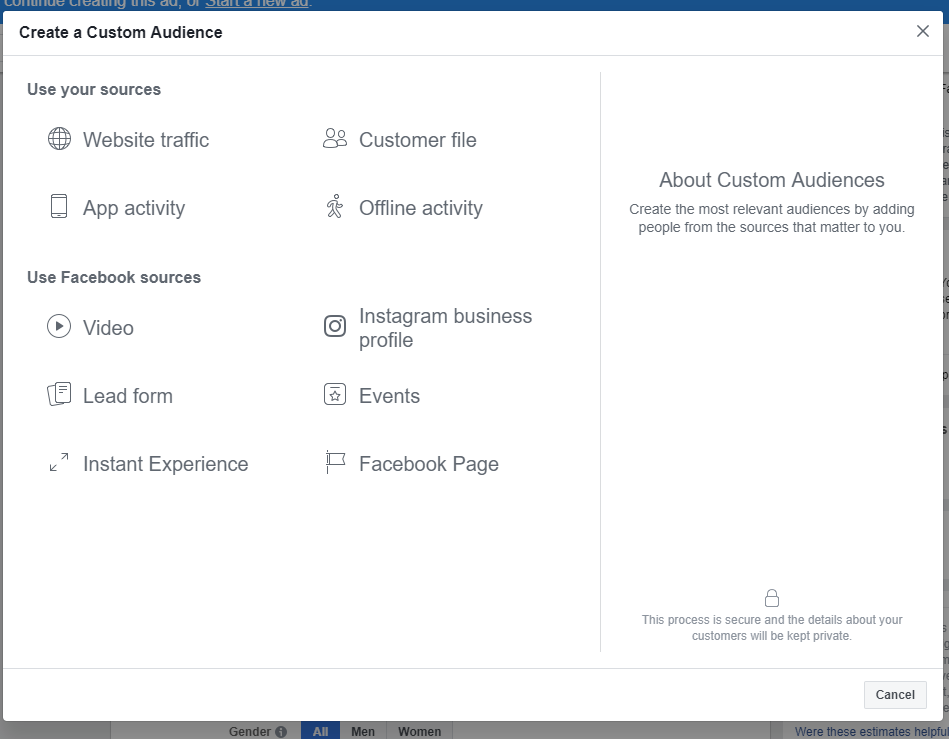
Customer file
The Customer File option allows you to import a list of email addresses, commonly a newsletter mailing list, which will then be cross-referenced with Facebook’s own database to create an audience from all users that match. Note that it’s unlikely that your whole list will be matched as your users may have a different email address associated with their account.
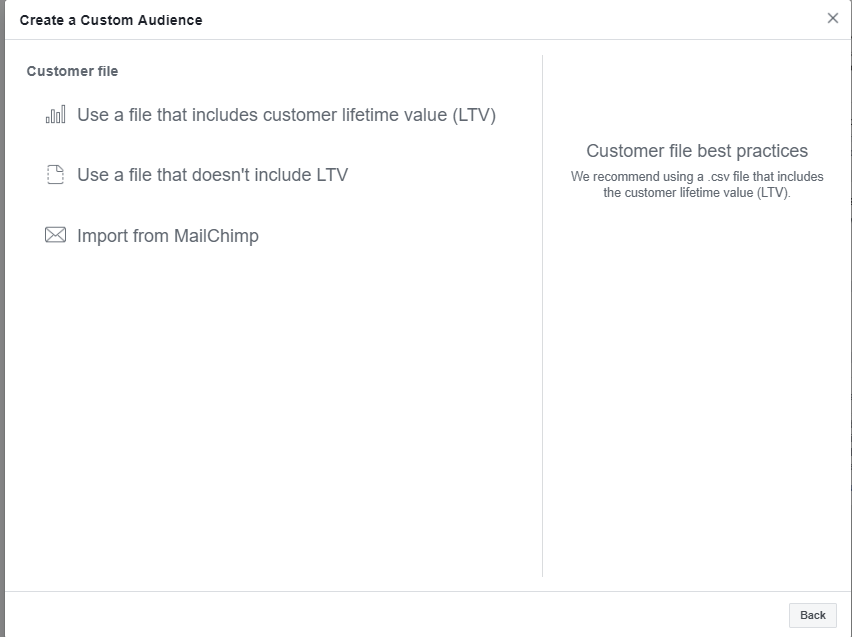
The Customer File audience is a great way to target your newsletter subscribers or app users. To create a Facebook Custom Audience, follow these steps:
- Create a Facebook Custom Audience
- Select the “Customer File” option
- Select whether you wish to add a customer file or import contacts from a list.
- Import your customer data to create a new Custom Audience
- Select the identifiers
- Upload a customer file
- Give your Custom Audience a name
Your customer files can include 15 different identifiers, the most popular ones being email, phone number and mobile advertiser ID.
Web traffic
You could segment those customers who have visited your Blog or a certain page of your website offering a promotion or demo of your brand or product. These Clients already know your name and have been interested enough to visit you but not to convert. These are high-value audiences as the users seeing your ads have already shown some interest in it. Important! To create audiences based on your website traffic, you first need to install Facebook Pixel. Learn everything about pixels here: Once you’ve installed the Facebook Pixel, you can simply go to the Audience Manager and create a Custom Audience based on past website traffic.
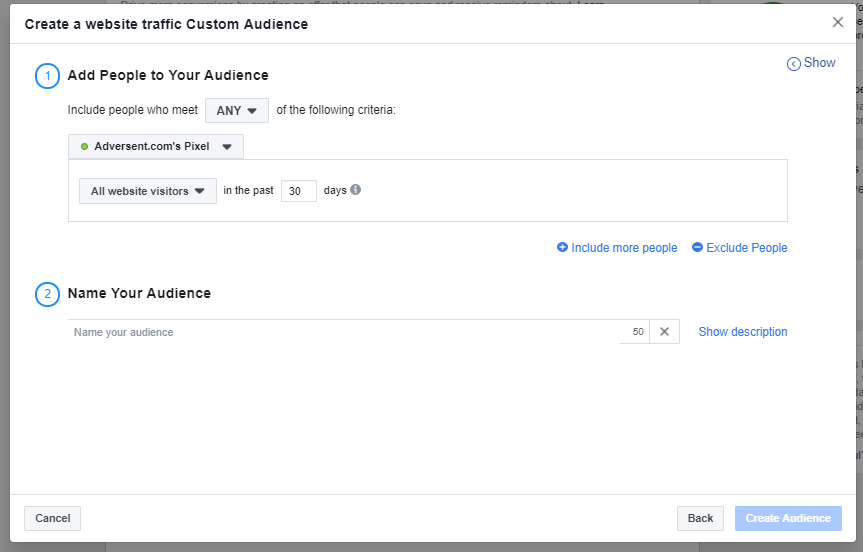
App Activity
If you want to reach the people who have engaged with your iOS or Android app, you can set up a Facebook target audience to do that. To target people based on the app activity, you first need to register your app and set up app events.To create a Facebook Custom Audience based on app activity, target people who have taken specific actions (events) in your app. You can also select the timeframe for targeted events.
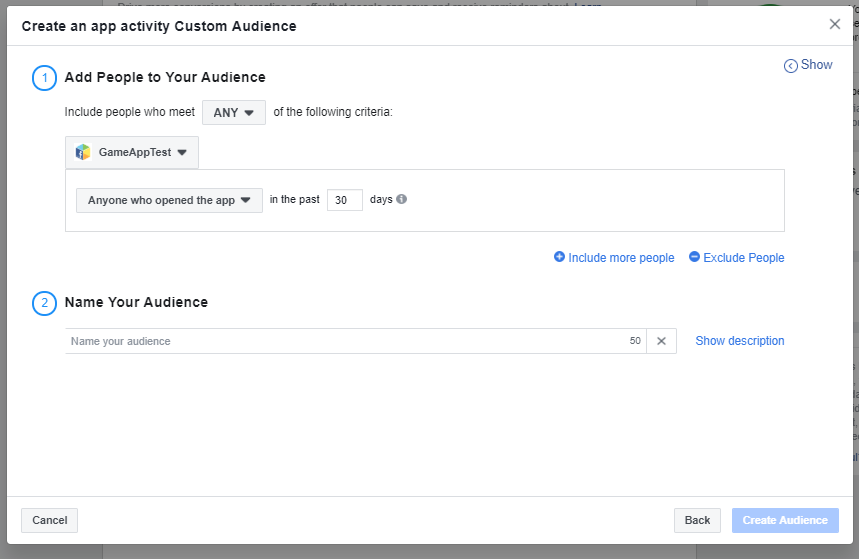
Offline Activity
This option requires some custom events, so remember to have these set up before you move forward!
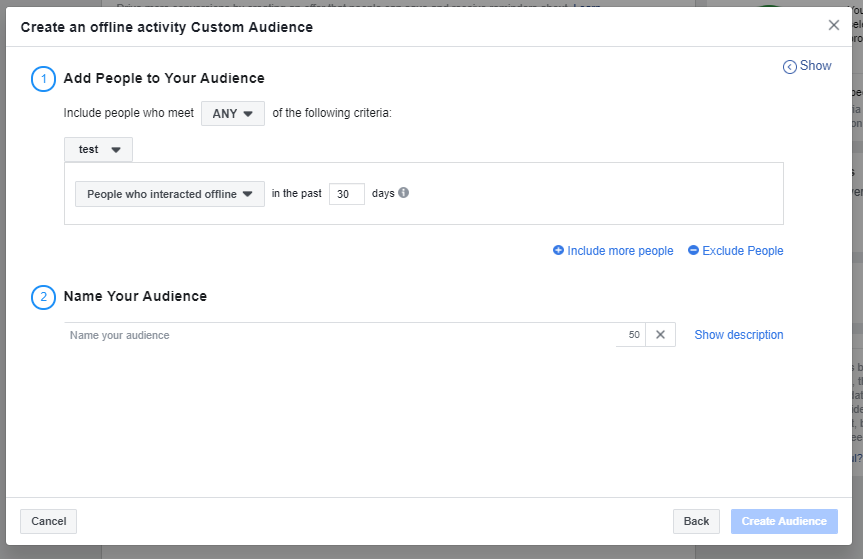
Offline events take your customer files or mailing list data even further, transforming it from a static file, to one that can be updated with nuanced data over time.
A great use for this feature is to help lead-based businesses attribute revenue to their contact conversions, as you can associate an offline purchase event with revenue value to a contact (using email, phone, country, or other data) and match it to Facebook’s which will attribute the sale to the specific ad. This feature is even ahead of Google Analytics!
It’s also great for event attendees or retailers, so if you have an eagle eye on your customers you can be an offline event ninja, enriching their data profile with every action. These offline conversions can also be used to build a custom audience, of for example users that purchased offline, or attended an event twice, or just about whatever you like.
Creating Custom Audiences Based on Engagement
Did you know that you can also target the users that have engaged with your content on Facebook, e.g. viewed your videos or liked a Page post? The latest addition to Custom Audiences is the possibility to target people who have done one of the following:
- Visited your Facebook Page
- Engaged with your Facebook Page posts or ads
- Clicked on any call-to-action buttons
- Sent a message to your Page
- Saved your Page or posts

This gives you the perfect opportunity to reach high-potential audiences that are interested in learning more about your brand or product.
This also works “on the other side”, you can increase the efficiency of your campaigns and avoid irrelevant clicks by excluding the list of your existing clients. For example, if you were offering a free trial period to new users, it would not make sense to show it to your current customers. Add or exclude the entire list, or just some features of the list using targeting parameters that help you create the Ideal Custom Audience.
This is extremely powerful. You can target your existing customers who have a certain type of work, certain types of mobile devices or who live in a certain zip code. In this regard, we should bear in mind that not all the information we give to Facebook is true, but it is worth trying. This Ads segmentation can help you increase your closing percentage and meet your goals.
Expand your targeting to a lookalike audience.
Working with your lookalike Audiences is the step to follow once you have defined your custom audience strategies. Even if you do not have your own database, you can use your list of followers on Facebook.
Lookalike audiences allow you to expand your reach and at the same time segment to audiences with specific profiles creating audiences that resemble your own clients.
If you do not have a list or if you have few followers, you can use a Facebook tracking pixel on your website or landing pages to create your personalized audience. To create a Lookalike Audience, you first need to create a Custom Audience to tell Facebook what type of users you want to reach.Next, select the “Lookalike Audience” from the audience creation menu and select a target country and a percentage (1%-10%) of the targeted country’s Facebook users. The percentage signifies the people most similar to your selected Custom Audience.
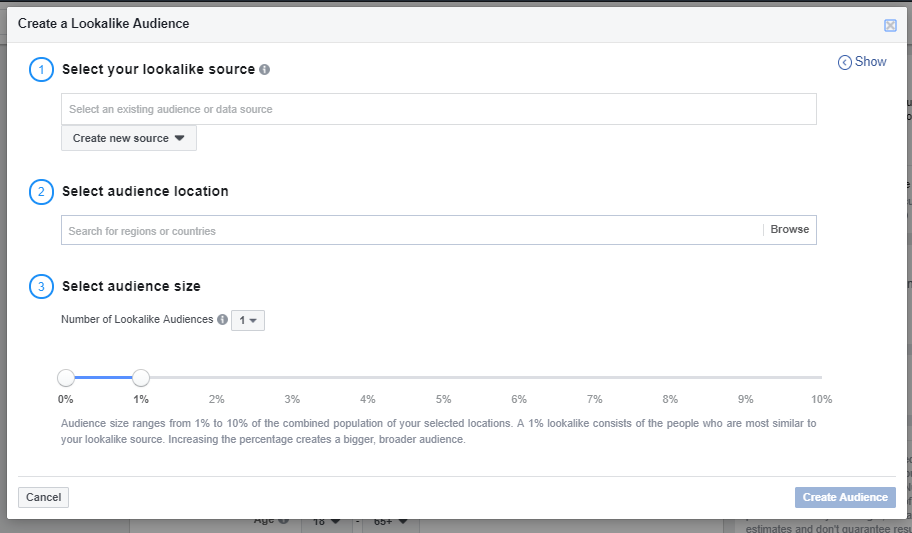
Once you have decided which audience you want to replicate and expand, you can make your audience larger (broad) or smaller (more specific and similar to your original audience), we recommend leaving it at 1%.
Get super granular with layered targeting options
Something super interesting and useful is the ability to combine the different segmentation options with each other, making your audience more and more specific gradually. You can use combinations of geolocation, behaviour and demographics. For example A moving company that promotes a special discount for senior citizens could go to people who bought a house in the last month, with an age range of 60 years or more and add only their service area.
If you can understand the intent, the needs and the likelihood of response of any particular audience segment, you can combine the different targeting options of your Facebook ads to take advantage of them.
Final thoughts
You do not have to choose just one of the above strategies. Check each of them and see how they can fit into your different market segments.Work on your customer archetypes – who are your ideal customers? Where they live? What do they do and what do they do after work? What traits and characteristics could they have and how do they align with the many segmentation parameters mentioned above?
The most important part is testing different hypotheses and basing your decisions on real data instead of assumptions. The tricky part now is to analyse this valuable data so you can make better campaigns, reach your objective and business decisions based on hard data. Lucky for you we’ve created this article that will explain “How to use Facebook Analytics to Grow Your Business”.
Try Demo – Filed, Marketing Software
Follow us on Instagram for blog updates – Instagram, Filed AI



